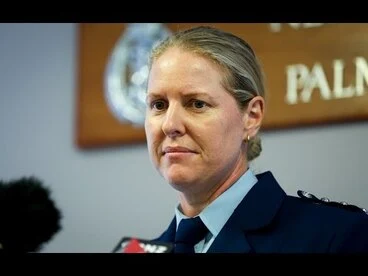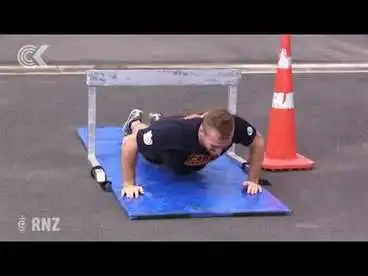Women in NZ Police
A DigitalNZ Story by Zokoroa
This pictorial tribute illustrates the journey of women as police officers in supporting our community as their role (and uniform!) diversified since the first recruits began their training on 3 June 1941.
Women in police, policewomen, policewoman, police, policing, police officer, women, cops, constable, careers
This DigitalNZ Story looks at the journey taken by the first women recruited to join the NZ Police who began their training on 3 June 1941 and their changing roles (and uniforms) over the decades. A timeline is also given of the career and training firsts for policewomen. Times have changed from when the criteria to be accepted as a police recruit included being between the ages of 25 - 40 years, unmarried or widowed, knowing shorthand and able to use a typewriter! If you fancy a career change - NZ's oldest police graduate was a woman who was 57 years of age in 2021.
On 3 June 1941 the first ten women recruited in the New Zealand Police began their training at Wellington
Image: On 75th anniversary of the first intake, national celebrations were held in 2016
Radio New Zealand
Dec 1952: Policewomen were issued with uniforms
Previously, they wore civilian clothing, including hats & gloves during summer & winter, when on duty
Manatū Taonga, the Ministry for Culture and Heritage
1955: Pat Mathieson was the first Māori policewoman
Alexander Turnbull Library
1958: Policewomen also became traffic officers
Roles expanded over decades; eg Inspector, Forensic investigator, Armed Offenders & Dive Squads, Maritime & Eagle Units
Alexander Turnbull Library
1974: Three women take out the top 3 awards & Prater Memorial Prize at the Police Training School at Trentham
Alexander Turnbull Library
2004: Mandeep Kaur was NZ's first female Indian police officer (& later Senior Sergeant)
(Video of Constables Mandeep Kaur & Lavleen Kaur, 18 Nov 2018)
Tagata Pasifika
2014: Reality TV series 'Women in Blue' was launched, showcasing the work of NZ Policewomen on TV One
Alexander Turnbull Library
2021: Policewoman Kelly Povey beside her police vehicle
Alexander Turnbull Library
FIRST WOMEN began POLICE training on 3 JUNE 1941
The New Zealand Police Force was established under the Police Force Act, 1886, which came into operation on 1 September of that year. Fifty-two years later, under Section 45 of the Statutes Amendment Act (1938), women could be appointed as police officers. On 3 June 1941 the first ten women recruited as police began their training at Wellington. After completing the three-month training course, the women were attached to the detective branch as temporary constables in Auckland, Wellington, Christchurch and Dunedin. Their role mainly involved supporting the welfare of women, young girls and children. Subsequent graduates, were also appointed to office duties. Eventually, women constables gained permanent employment in 1947. As of 30th April 2021, women comprised 35.8% of all New Zealand Police staff and 23.5% of constabulary staff.
Sources:
Spot the changes in uniform over the years!
A chronological summary of the changes to the uniform worn by policewomen over the decades can be viewed on the New Zealand Police website under Women in uniform - What we wore.
For the first ten years uniforms were not worn by policewomen who were required to wear civilian clothing, including hats and gloves during summer and winter, when on duty. During 1942 and 1943, women MPs had recommended to the House of Representatives that uniforms be provided, but met with a mixed reaction. It was not until December 1952 that policewomen were issued with an uniform and a gabardine raincoat.
Dec 1952: Policewomen issued with uniforms after women MPs recommendations to House of Representatives during 1942-43
Navy tunic/jacket, white shirt (men wore a blue-grey shirt) with detachable collar with studs & navy tie (Photo: 1955)
Alexander Turnbull Library
The policewoman's initial uniform consisted of a navy, broad-brimmed felt hat with a police badge, open necked button front navy tunic / jacket, white shirt (men wore a blue-grey shirt) with a detachable collar, navy tie, three--quarter length navy skirt with a belt, gloves, black stockings and laced up shoes. For an historic overview of badges, see information sheet compiled by Ken Bewer: 'NZ Police Badges': https://www.ipa.org.nz/pdfs/NZ_Police_Badges.pdf
1953: St. Edwards Crown cap badge
New cap badge designed with the St. Edwards Crown & the words 'NZ POLICE'' in curved form
Manatū Taonga, the Ministry for Culture and Heritage
1957: Wide-brimmed hat replaced by a cap
Three--quarter length navy skirt with belt, gloves, black stockings & laced up shoes (Photo: Constable Kathleen McAlley)
Palmerston North City Library
Wearing new Tudor Crown badge
In 1956, the Tudor Crown badge was replaced St Edward's Crown following Queen Elizabeth II’s accession to the Throne
Alexander Turnbull Library
1958: Traffic officer wearing helmet badge design
The hat displays the first helmet badge design with the Tudor Crown badge
Alexander Turnbull Library
1972: Optional uniform introduced
Calf-length leather boots became an optional extra to be worn with a shorter skirt length
Alexander Turnbull Library
Shoulder bag
Had a keylock for security & held handcuffs, baton, coin purse & small vanity mirror
Christchurch City Libraries
Police wooden batons
Shorter baton carried by women police from 1960s so as to fit in their handbag
Alexander Turnbull Library
1976: Uniforms became lighter vitric blue with mazarine blue cotton polyester shirts & no belt
Register number now affixed to epaulettes & new woven 'NZ Police' coat of arms crest at top of sleeve
Alexander Turnbull Library
1977: Modelling new uniform (Left & Middle); Old uniform (on Right)
Women's skirt simple A-line instead of box pleats; new women's felt hat (white version provided for summer)
Alexander Turnbull Library
1978
Policewomen wearing medals for long service & good conduct - Isla Jones (left), & Roa Morrissey
Alexander Turnbull Library
1979
Police Constable Vickie Gaudie wearing the new policewomen's uniform with trousers
Alexander Turnbull Library
1986: White summer hat issued upon graduation
Women could also wear short sleeved shirt with smaller epaulettes with round plastic numbers, and no tie
Alexander Turnbull Library
In 1989, a pregnancy uniform for policewomen became available: ‘a vitric blue smock with patch pockets worn with the regulation police shirt, tie, epaulettes and number.’ Two uniforms were issued which were to be returned afterwards. See photo: New Zealand Police: Women in uniform - What we wore
1991: Headgear the universal forage cap
Summer option of short-sleeved shirt & wearing culottes or shorts, navy walk socks & black shoes when on beach patrol
South Canterbury Museum
1993: Regulation shirt with tie
Constable Lara Pomroy & Carroll Benge
South Canterbury Museum
1993: Constables wearing trousers on bicycles
Constables Karen Ellis (left) & Rose Crawford on bicycles in Porirua
Alexander Turnbull Library
1994: New wide-brimmed Akubra style rabbit fur felt hat was introduced for duties in hot summer sun
Women’s blouses to be replaced with shirts similar to men’s style
Alexander Turnbull Library
1995: New police patrol jersey being modelled by Police Sergeant Rose McDermott
Skirts, cullottes or trousers continue to be optional. Since 1987, skirts could not be worn above centre of knee cap.
Alexander Turnbull Library
1996: Choice of trousers or culottes become standard dress
Following staff review (1995), skirts ceased being worn with the choice of trousers or culottes becoming standard dress
South Canterbury Museum
Oct/Nov 2000
Two new community constables Rachael Ball & Ian McDonald
Upper Hutt City Library
2002
Community Constable Rachel Ball wearing trousers at new office in Logan Plaza.
Upper Hutt City Library
2010: Senior Constable Anna Stenhouse wearing police body armour with pouches for tactical gear
(Anna with National MP Kate Wilkinson & Minister of Police Judith Collins (on Right))
UC QuakeStudies
2011: Police tactical equipment includes radio, baton, handcuffs, taser, OC pepper spray & firearm
(Woman police officer distributes supplies to members of emergency services after Christchurch earthquake)
UC QuakeStudies
2016
Police Inspector's hat was all blue with braided peak inserted at the front
Radio New Zealand
2019
Armed women police officer after Christchurch mosque shootings
Museum of New Zealand Te Papa Tongarewa
2020
Hijab approved for NZ police uniform in Nov 2020, & adopted by UK & Australia's Queensland cops
Radio New Zealand
Diverse range of policing roles over the decades
Nationally, the New Zealand Police has 12 Districts (nine in the North Island and three in the South), which are administered from the Police national headquarters in Wellington.
The Chief Executive of Police, known as the Commissioner, is appointed by the Governor General and is accountable to the Minister of Police for the administration of police services.
The Executive leadership team comprises the Commissioner, Deputy Commissioners, Deputy Chief Executives, & the Director of the Office of the Commissioner.
Each of the 12 districts have a District Commander and a team of Area Commanders who manage the day-to-day operations.
As of 30th April 2021, women comprised 35.8% of all New Zealand Police staff and 23.5% of constabulary staff.
Prior to being eligible for formal police training in 1941, women had been involved in various roles such as police matrons of stations and as female searchers. As trained police, women were initially involved working with women, young girls and children; and/or office duties. Over the years, the range of roles for policewomen has diversified including, for example, traffic officer, community constable, dog handler, inspector, forensic investigator, Armed Offenders Squad, Dive Squad, Maritime Unit, Air Support 'Eagle' Unit, and leadership positions such as District Commander.
For a current list of the range of roles, see Police: Structure which includes: Commissioner and Executive, Police teams and units, and Police districts.
Pre-1941
‘Police matrons’ dealt with females who had been arrested
National Library of New Zealand
Te Ara article: Modern policing (includes introduction of policewomen)
Manatū Taonga, the Ministry for Culture and Heritage
From 1941: Constables in detective branches & wore civilian clothing until Dec 1952
Trained policewomen initially worked on cases involving women, young girls & children, &/or office duties
Alexander Turnbull Library
Traffic officers
Photo: Heather Thorne is the first woman traffic officer in Wellington, 1958
Alexander Turnbull Library
Detectives
First women were appointed in 1957, paving way for others like Detective Inspector Fiao’o Faamausili (Photo 2016)
The Coconet TV
Coroner's Court
Photo of Police Sergeant Nancy Thompson, 1974
Alexander Turnbull Library
Dog handlers
Photo of Upper Hutt Police Dog Training Centre kennel manager Marilyn Jensen with Zara, 1977
Upper Hutt City Library
Senior fingerprint technicians
First woman appointed 1978. (Photo: Jayne Sutherland & Anne Guest who were 1st direct entry into training course, 1984)
Alexander Turnbull Library
Police telecommunications
Alison Fox was one of two women starting a four-year course, 1986
Upper Hutt City Library
Traffic Officers providing cycling training in schools
Photo of Traffic Officer Toni Hocking, 13 Nov 1990
South Canterbury Museum
Public Safety Team operations, including crowd control during events
Photo of Waitangi Day, 1993
Manatū Taonga, the Ministry for Culture and Heritage
Police Court Matrons
Photo of Gail Jacobson, seated in a police car, with flowers given to her by the Black Power gang, 1995
Alexander Turnbull Library
Armed Offenders Squad
Photo of Wellington's only woman Police Armed Offenders Squad member, Sacha Haskell, in 1995
Alexander Turnbull Library
Police Negotiation Team (PNT)
Each Armed Offenders Squad has a Police Negotiating Team attached to it
Radio New Zealand
Traffic accidents
Photo of Constable Denise Keneally tending to a cat hit by a car, 2000
Upper Hutt City Library
Dive Squad
(Photo: Members of the National Police Dive Squad, 2005)
Manatū Taonga, the Ministry for Culture and Heritage
Forensic investigators
Photo: Rachel Nickerson, a crime scene attendant with the Auckland police, 2006
Manatū Taonga, the Ministry for Culture and Heritage
Road Policing
Photo: Police officer uses a speed-measuring laser device, 2009
Manatū Taonga, the Ministry for Culture and Heritage
Community Constables & Neighbourhood Policing Teams
Photo: Blitz on truancy, 2009
Manatū Taonga, the Ministry for Culture and Heritage
Canterbury Earthquake Reassurance Policing team
Timaru Police Constable Cath Hone & St Andrews Constable Tim Hartnell during Canterbury earthquake clean-up, Sept 2011
UC QuakeStudies
Diplomatic Protection Squad
Radio New Zealand
2014: Reality TV series 'Women in Blue' is launched
Showcased the work of NZ policewomen on national network TV One
Radio New Zealand
Air Support 'Eagle' Unit
Radio New Zealand
Police Maritime Unit at Auckland & Wellington
Video includes Lady Elizabeth IV (on which Constable Paula Tanuvasa was first female crew member in Wellington, 2014)
Radio New Zealand
Commercial Vehicle Investigation Unit
Radio New Zealand
Terrorism response operations
(Article: First responders to be honoured after Christchurch mosque shootings, 2019)
Radio New Zealand
Police checkpoints
(Photo during a Covid-19 lockdown, 2021)
Museum of New Zealand Te Papa Tongarewa
Detective Inspector
(Article: Interview with Karen Bright, the District Inspector of Counties Manukau, Jan 2025)
Radio New Zealand
Area Commander
Photo of Andrea McBeth, Area Commander for Hamilton City, 2020
Radio New Zealand
District Commander
Photo of Superintendent Karyn Malthus (2018), Auckland District Commander who was previously Tasman District Commander
Radio New Zealand
TIMELINE:
The campaign for policewomen: 1890s - 1910s
The New Zealand Police Force was established under the Police Force Act, 1886 which came into operation on 1st September that year. Prior to that date policing had been carried out by members of the Armed Constabulary, which was then disbanded. Some of its members were transferred to the newly constituted Police Force and others to the Permanent Militia, later renamed the Permanent Force which evolved into being the Royal New Zealand Artillery.
The journey since then to appoint women as police officers was advocated by women's groups and other national organisations. They proposed that women police would help safeguard the welfare of women and children and be involved with courtwork. Opposition from various sectors, including senior police officers, discounted the suitability of women for carrying out the range of policing work performed by men. In 1916, the Minister of Justice (Hon. A. L. Herdman) declared it would be "folly" to appoint women with the full powers of police officers and proposed having patrol officers.
WOMEN'S POLITICAL ASSOCIATION. (Star, 22 August 1896)
National Library of New Zealand
WOMEN AS POLICE (Otago Daily Times 24-3-1915)
National Library of New Zealand
WOMEN POLICE (Otago Daily Times 15-9-1915)
National Library of New Zealand
WOMEN POLICE. (Taranaki Daily News 3-4-1916)
National Library of New Zealand
WOMEN POLICE (Otago Daily Times 19-10-1916)
National Library of New Zealand
WOMEN POLICE (Otago Daily Times 15-12-1916)
National Library of New Zealand
WOMEN POLICE. (Clutha Leader 23-1-1917)
National Library of New Zealand
WOMEN POLICE (Otago Daily Times 25-6-1917)
National Library of New Zealand
WOMEN POLICE. (Colonist, 18 July 1917)
National Library of New Zealand
WOMEN POLICE (Otago Daily Times 17-7-1917)
National Library of New Zealand
WOMEN'S NATIONAL COUNCIL (Evening Post, 28 May 1918)
National Library of New Zealand
NATIONAL COUNCIL OF WOMEN (Evening Post, 10 September 1919)
National Library of New Zealand
The campaign for policewomen: 1920s - 1930s
The support for appointing policewomen continued during the 1920s and 1930s with lively debate drawing on the examples of other countries, such as Australia, Canada, England, Scotland and the United States. However, in 1929 the Minister of Justice (Hon. Thomas Mason Wilford who was appointed from 10 December 1928 to 10 December 1929) stated that women would not be appointed as police. After Peter Fraser became Minister in Charge of Police on 6 December 1935, he set history in motion by announcing in 1938 that women will be appointed as police. This led to the Statutes Amendment Act being assented to on 16 September 1938 whereby Section 45 provided the authority to introduce women as police in NZ:
Police Force. 45.
The powers conferred by the Police Force Act, 1913, to appoint members of the Police Force (including temporary members) are hereby extended so as to include power to appoint women to be members of the Force, and all references in the said Act to the Force and to the members of the Force shall be deemed to include the women members thereof..
During 1920s, support for appointing women as police continued
National Library of New Zealand
Campaign for policewomen drew on examples of other countries
eg Australia, Canada, England, Scotland & United States
National Library of New Zealand
However, in 1929 the Minster of Justice, Hon Thomas Mason Wilford, stated women would not be appointed as police
(Milford was appointed Minister of Justice from 10 Dec 1928 - 10 Dec 1929)
National Library of New Zealand
During the 1930s, the campaign for having policewomen continued, including deputations by the National Council of Women
(NCWNZ had formed in 1896, 3 years after women were first granted the vote in NZ, & had gone into recess from 1906-1918)
National Library of New Zealand
An advocate for the work policewomen did overseas was Janet Fraser - wife of the MInister of Police Peter Fraser
(See Evening Post article (1 April 1938) on Janet addressing Society for the Protection of Women and Children)
National Library of New Zealand
In 1938, Police Minister Peter Fraser announced that research led him to conclude women to become police asap
Peter was appointed Police Minister on 6 Dec 1935. (ArtIcle: Peter on right at Palmerston North Police Station, 1938)
Auckland Libraries
On 16 Sept 1938, Statutes Amendment Act was passed - Section 45 provided the authority to introduce women police into NZ
The University of Auckland Library
Training programme developed - 1941
The admission of women, which had been previously resisted by senior police officers, was agreed to as men were being recruited into the wartime military. The position description and training programme were developed, drawing on overseas examples. They had to be between 25-40 years; unmarried or widowed; have ‘superior education’ and common sense; know shorthand and able to use a typewriter. A number of applications were received for the first intake of ten women on 3 June 1941. The recruits were selected by the Police Commissioner Denis Cummings and their three-month training course was held at a depot on Rintoul Street in Newtown, Wellington.
3 June 1941: Training begins for first 10 women recruits at the Police Training school on Rintoul St in Wellington
Criteria: Aged 25-40 years; unmarried or widowed; have 'superier education' & commonsense; know shorthand & able to type
Manatū Taonga, the Ministry for Culture and Heritage
When their training was completed, a parade was held on 1 October 1941 at which the women graduates were addressed by the Prime Minister Peter Fraser.
"Addressing the women on parade yesterday, the Prime Minister (Mr. Fraser), told them that they represented an innovation in the Police Force, and that the selection had been made with very great care. He was pleased with the progress they had made, and with the results of their examinations. As pioneer policewomen, he felt that they realised that a great responsibility rested on their shoulders. The Government was particularly anxious that the experiment should be an unqualified success, and he had confidence that the women who were going out on duty would work honestly, earnestly, and efficiently in the discharge of their responsible tasks, and that the result would bring benefit to the community, particularly to women and children."
Source: Papers Past: Evening Post: "A responsible task" (Vol. CXXXII, Issue 81, 2 Oct 1941, p. 10)
1 Oct 1941: Prime Minister Peter Fraser addressed the parade of 10 policewomen graduates
They'd completed the three-month training course held in a house in Rintoul Street in Wellington
National Library of New Zealand
Women in Blue - CAREER & TRAINING FIRSts
Following the training of the first intake of policewomen in 1941, there has been an ongoing recruitment campaign to increase the numbers. Over the decades there have been many notable career and training firsts for women within the New Zealand Police.
The following information has been extracted from New Zealand Police: New Zealand Policewomen 75 years timeline and iiiustrated with images and articles available on DIgitaNZ.
>>>>>>>>>>>>>>>>>>>>>>>>>>>>>>>>>>>
During 1940s, career & training firsts for policewomen included:
- 1941: The first 10 policewomen were recruited in June. They had to be between 25-40 years, unmarried or widowed, know shorthand and able to use a typewriter. After training they were attached to the detective branch as temporary constables at Auckland, Wellington, Christchurch and Dunedin.
- 1941: First policewoman to make an arrest (Constable Edna Pearce in November)
- 1941: Constable Edna Pearce was seconded to the Department of Internal Affairs to take charge of an internment camp for Japanese women and children at Pokeno in the Waikato
- 1945: Policewomen were allowed to join the Police Association
- 1946: Members of the New Zealand Police Force had to gain permission to marry. When the first couple applied (Constables Peggy McKenzie and Bill Hedley) the Commissioner passed their request to the Prime Minister to make the decision.
- 1947: Policewomen were granted permanent appointment
- 1948: Constables Rose Dudfield and Flora McDonald spend three months in Sydney on an exchange working with Australian policewomen
- 1949: A total of 52 policewomen had been trained but only 39 remained as most left when they married
1st graduates were assigned to detective branch as temporary constables at Auckland, Wellington, Christchurch & Dunedin
Role was to support welfare of women, young girls & children; & they could make arrests but weren't issued with a baton
National Library of New Zealand
Two of the graduates were assigned to Christchurch: Constables Nancy Aitchinson and Molly Spearman. "As women weren't issued with uniforms in those days, and instead wore civilian clothing, it made them ideal for undercover work. They were used in seeking evidence of sly grogging, bookmaking and in searching ships and opium dens for women.". After thirteen years at Christchurch, Nancy transferred to Napier where she retired in 1970. She was awarded the Coronation Medal in 1953 and her 28-year service clasp at the Christmas Day parade at the Napier Police Station by when she was "the oldest serving member of the Women’s Division of the Police in New Zealand" . (Source: New Zealand Police: Policewomen over the decades: Nancy Aitchinson.)
In 1941, 1st policewoman to make an arrest was Constable Edna Pearce in November
Edna was then seconded to DIA's internment camp of Japanese women & children until 1943. (See interview held 1990)
Ngā Taonga Sound & Vision
29 July 1943: Mrs. Dreaver (Waitemata MP) asked for more women police & for uniforms, during Parliamentary session
PM advised Police Commissioner has arranged a conference with Ak civic authorities, churches, & women's groups next week
National Library of New Zealand
In 1943, Marie Storey was part of the third intake of women to join the police force (See RNZ interview, 2020)
Storey completed a three-month female-only training programme which was held over the summer
Radio New Zealand
The third intake of women to join the police force in 1943 included Constable Marie Storey. "By the time Marie joined it was thought that it was better for experienced women to explain aspects of the job to the new trainees, so Marie and the other female recruits in her intake were often given lectures and on-the-job training from women who had been in the job for a few years... During her time as a policewomen, Marie and the other women were often used as decoys to help catch offenders...Marie married and left the New Zealand Police in 1947 when she became pregnant with her first child." (Source: New Zealand Police: Policewomen over the decades: Marie Storey.)
By Jan 1945, there were 20 policewoman in NZ: Auckland (6), Wellington (6), Christchurch (4) & Dunedin (4)
National Library of New Zealand
In 1945, policewomen were allowed to join New Zealand Police Association & were granted permanent appointment in 1947
A 3-month exchange visit was also held by Constables Rose Dudfield & Flora McDonald in Sydney with policewomen in 1948
Museum of New Zealand Te Papa Tongarewa
In 1946, when Constables Peggy McKenzie & Bill Hedley wanted to wed, the Commissioner sought PM Peter Fraser's assent
(A women constable was expected to resign when wed in case she was influenced in her work by her husband.)
Manatū Taonga, the Ministry for Culture and Heritage
By 1949, a total of 52 policewomen had been trained but only 39 remained as most had left when they married
They were assigned to police stations in Auckland, Wellington, Christchurch, & Dunedin. (Image: Auckland Police Station)
Alexander Turnbull Library
During 1950s, career & training firsts for policewomen included:
. 1950: Police driver delivering constables to enquiries, escorting prisoners and delivering documents (Constable Josephine Brophy) . 1951: Policewomen are officially recognised and their appointments appear in New Zealand Police Gazette for the first time. . 1952: Policewomen are issued with uniforms . 1953: Train as detectives (Constables Molly Sim and Nora Crawford) . 1954: Commissioner Compton issues a new policy that required approval of the Police force for the marriage of a policewoman while she is still in the force . 1954: First policewoman appointed to the Hamilton Police Station (Constable Edna Pearce who retired at 60) . 1955: First woman to work in Criminal Investigations Branch (CIB) (Constable Nora Parker who retired from CIB in 1978) . 1956: Policewomen began training with their male colleagues for the first time and made up 3.20% of the Police Force . 1956: First policewoman to graduate at the top of her training course (Pam Anderson who later married and became Pam Sowter) . 1957: Awarded the Minister's Prize (Pamela Anderson) . 1958: First policewoman to reach the rank of detective (Nora Crawford) . 1958: All provincial HQ stations except Timaru had policewomen . 1959: Maternity leave of up to 6 months was granted
1950: Constable Josephine Brophy becomes a police driver
Delivered constables to enquiries, escorted prisoners & delivered documents
Alexander Turnbull Library
1951: Policewomen are officially recognised with appointments in NZ Police Gazette appearing for first time
Alexander Turnbull Library
!952: Policewomen are issued with uniforms: navu tunic/jacket, white shirt & 3/4 length navy skirt
Also wore a navy hat with police badge, navy tie, gloves, black stockings & black laced uo shoes
Alexander Turnbull Library
1954: Commissioner Compton issued policy that required the approval of Police force for a policewoman to marry
Later in 1959, maternity leave of up to 6 months was granted. (Photo of two Detectives marrying in 1955)
Alexander Turnbull Library
In Nov 1954, Constable Edna Pearce was the first policewoman to be appointed to the Hamilton Police Station
Edna joined with 1st batch in 1941; was awarded a police long-service medal in 11956, & retired in 1966 aged 60 years
Hamilton City Libraries
1955: Constable Nora Parker was first woman to work in Criminal Investigations Branch (CIB) & joined Fraud Squad in 1969
Nora received Queen’s Silver Jubilee Medal in 1977 & long service & good conduct medal in 1978 & retired in 1978
Wikipedia
1956: Policewomen began training with male colleagues for 1st time & Pam Anderson was 1st woman to be top graduate
Pam later married & became Pam Sowter
Alexander Turnbull Library
1956: Policewomen made up 3.20% of the Police Force & received 80% of male constable's pay
By 1958, all provincial police headquarter (HQ) stations except Timaru had policewomen
Alexander Turnbull Library
1957: Pamela Anderson was the first woman recruit to gain the Minister’s Prize
Alexander Turnbull Library
During 1960s, career & training firsts for policewomen included:
. 1961: Sergeant in charge of Auckland’s women’s division (Detective Elizabeth Bennett) . 1963: The entry age was lowered to 20 - 33 years. Applicants had to be at least 5 ft 5 in. tall, of good health, of proved character, & of British nationality . 1963: Policewomen in training taught to handle .32 calibre Colt pistols and .303 calibre rifles. . 1965: Equal pay for policewomen advocated by Commissioner Spencer, which Cabinet approved. Previously, women received 80% of a male Constable’s pay. . 1965: At the end of March 1965 there were 51 policewomen in the New Zealand Police . 1966: Women’s division was disbanded by Commissioner Spencer who directed that policewomen be employed on all general policing duties . 1966: Sgt Elizabeth (Betty) Bennett was first policewoman to become a commissioned officer and was transferred as an inspector to Police National Headquarters; Detective Jean Dougal to Detective Sergeant; & Constable Edna Pearce retires after 25 years. . 1969: There are 69 policewomen.
1961: Detective Elizabeth Bennett promoted to Sergeant in charge of Auckland’s Women’s Division
Auckland Libraries
1963: Entry age lowered to 20-33 years & had to be at least 5ft 5 inches tall & of British nationality
(Image: In 1963, policewomen in training taught to handle .32 calibre Colt pistols & .303 calibre rifles)
Waimate Museum and Archives
In 1965, equal pay for policewomen advocated by Commissioner Spencer which Cabinet approved (were receiving 80%)
Auckland Libraries
At the end March 1965, there were 52 policewoman
(Image: Traffic Officer, March 1965)
Wellington City Council Archives
1966: Commissioner Spencer disbands Women’s Division & directs policewomen be employed on all general policing
That same year, Constable Edna Pearce retired after 25 years & had been Hamilton's only policewoman since Nov 1954
Alexander Turnbull Library
In 1966, Sgt Elizabeth Bennett was 1st female commissioned officer & transferred as an Inspector to national HQ
Detective Jean Douagll was appointed to the position of Detective Sergeant (Image: Wellington Police Station)
Wellington City Libraries
Commissioner Urquhart proposed reinstatement of Women's Division with Inspector Bennett at its head, which didn't occur
Bennett convinced other senior officers that policewomen had proved their worth in various policing situations
Alexander Turnbull Library
In late 1960s, women police constables were beginning to be assigned to general duties, including traffic
(Image: Police Officer Pam Stokes checking driver's licence, Aug 1967
Christchurch City Libraries
1968: Recruitment campaign for school leavers
By 1969, there were 69 policewomen
Alexander Turnbull Library
During 1970s, career & training firsts for policewomen included:
- 1970: 74 policewomen: 2.37% of the 'sworn" Police Force. (Unsworn staff were non-constabulary.)
- 1970: Longest serving policewomen (Nancy Aitchison who was amongst the first ten recruits in 1941, retired aged 60)
- 1970: Commissioner Sharp reactivated earlier initiatives to fully integrate policewomen into the service
- 1971: Sergeant in charge of a duty section (Constable Dorothy Parkes)
- 1971: Radio technician (Constable Stephanie Butel)
- 1972: Full-time prosecution duties (Detective Sergeant Jean Dougall)
- 1973: Full-time tele-printer operator (Constable Helen Price)
- 1974: Permission is given for the optional extra of long leather boots to be worn with the short and fashionable uniform skirts
- 1975: Linley Shute is the first policewoman to be named NZ Police sportsperson of the year
- 1977: Detective Inspector (Jean Dougall)
- 1977: Human Rights Commission Act S 16(1) allowed police to discriminate against women at recruitment level. The Executive agree that policewomen should make up no more than 4% of the service. Number currently 190 (4.39%).
- 1978: Police photographers (Constables Rosemary Gibson and Robin Christian)
- 1978: Senior fingerprint technician (Sergeant Anne Waugh)
By 1970, there were 74 policewomen in NZ (2.37% of the "sworn" police force). Unsworn staff were non-constabulary.
(Article about police at Mataura whose 22 officers include one woman: Constable Valda Barrett, 1970)
Mataura Museum
In 1970, new Police Commissioner Sharp reactivated earlier initiatives to fully integrate policewomen into the service
(Image: 1971: Police Constable with lost child, Gisborne, 1971)
Archives New Zealand Te Rua Mahara o te Kāwanatanga
1971: Otūmoetai College pupils join Sergeant S.W. Brierly of the Tauranga Police to find out about recruitment
Tauranga City Libraries
In 1971, Constable Stephanie Butel becomes the first female radio technician
That same year, Constable Dorothy Parkes was promoted to Sergeant, the first to be put in charge of a duty section.
Alexander Turnbull Library
!972: Constable Ann Barry (right) learns the ropes from her predecessor, Constable Barbara Milligan
Tauranga City Libraries
In 1972, Detective Saergeant Jean Dougall was appointed full-time on prosecution duties
Wellington City Council Archives
In 1972, Meryl Diffey of the Lower Hutt police was the first woman piper in the New Zealand Police Pipe Band
Alexander Turnbull Library
In 1973, Constable Helen Price became the first woman full-time tele-printer operator
(Image: Tele-printer used by police, 1971)
Tauranga City Libraries
1973: Constable Hazel Nash was the first to join the Search and Rescue (SAR) Squad
National Library of New Zealand
In 1975: Linley Shute is the first policewoman to be named NZ Police sportsperson of the year. (Basketball)
(Image: Basketball players)
Archives New Zealand Te Rua Mahara o te Kāwanatanga
In 1977, the debate about whether policewomen should be allowed to wear trousers begins
Previous year, policewomen given option of wearing longer boots with short skirts. (Image: Trousers worn by policemen)
Mataura Museum
1977: Human Rights Commission Act S 16 (1) allowed police to discriminate against women at recruitment level
The Executive agree that policewomen should make up no more than 4% of the service. Number currently 190 (4.39%)
NZ On Screen
During 1980s, career & training firsts for policewomen included:
- 1980: 210 policewomen (4.23%)
- 1980: First woman to be in charge of a smaller station (Sergeant Paula Stevens posted to Greymouth)
- 1981: 40 years of women in policing celebrated with a dinner in Hamilton attended by Commissioner Bob Walton
- 1981: Diploma of Police Studies at Massey University graduate (Constable Marie-Therese Scott)
- 1981: During the Springbok Tour, a few policewomen are issued with shields, helmets and Monadrock PR 24 batons.
- 1982: Dame Te Atairangikaahu Cadet Wing was the first to have female cadets. (There were 2 graduates in 1983 when the cadet system was suspended.)
- 1982: The first recruit wing with more female recruits than males - Wing 82 has 12 women and 11 men
- 1984: District Arms Officer (Constable Lynne Clark)
- 1985: First mother to graduate from the Police College. (Constable Lorraine Parkinson, 93 Wing). Prior to this women with dependent children were not accepted as recruits.
- 1985: Community Constable (Constable Elaine Tunnell)
- 1985: Sent overseas on an investigative brief (Detective Cushla Watson was involved with the Rainbow Warrior's case)
- 1985: First policewoman to receive the 35 year long service award on her retirement (Constable Rosalie Sterritt)
- 1986: Wing patron (Detective Nora Crawford)
- 1986: Recruit instructor at the Police College (Sergeant Anne Waugh)
- 1988: Received Merit Award for bravery (Constable Carmen Dickison)
- 1989: First time NZ policewomen served overseas. (Three women joined the team of 32 police members selected to go to UN mission in Namibia.)
- 1989: Constable Marlene Rangi received a special performance of duties
- 1989: A pregnancy uniform for policewomen became available: ‘a vitric blue smock with patch pockets worn with the regulation police shirt, tie, epaulettes and number.’ Two uniforms were issued and returned afterwards.
Also, during 1984, the first female Minister of Police was appointed - Ann Hercus (MP for Lyttleton). For a list of male and female position-holders since 1896, see: Wikipedia: Minister of Police (New Zealand).
By 1980, there were 210 policewomen appointed to the Police Force (4.23% of police)
In 1980, Sergeant Paula Stevens was 1st woman to be in charge of smaller police station (Greymouth)
Archives New Zealand Te Rua Mahara o te Kāwanatanga
In 1981, forty years of women in policing was celebrated at a dinner in Hamilton attended by Commissioner Bob Walton
That same year, first Diploma of Police Studies graduate at Massey University was Constable Marie-Therese Scott
Auckland War Memorial Museum Tāmaki Paenga Hira
1981: During the Springbok Tour, a few policewomen were issued with shields, helmets & Monadrock PR 24 batons
Museum of New Zealand Te Papa Tongarewa
1981: Scenes of Constable Marie Robertson appeared in 'A day in the life of a… policewoman', Weekend Star,
Weekend Star: Saturday, 20 June 1981, p.9.. (Image: Checking a burglary report at a store in Christchurch)
Christchurch City Libraries
During 1981, police training ceased at Trentham Military Camp when new Police Training College opened at Porirua
Upper Hutt City Library
In 1982, first recruit wing to have more women than men occurred: Wing 82 had 12 women & 11 men
Dame Te Atairangikaahu Cadet Wing was also first to have female cadets (2 graduated in 1983 when cadet system suspended)
Museum of New Zealand Te Papa Tongarewa
26 July 1984: Ann Hercus, MP for Lyttleton, became first female Minister of Police & was appointed until 16 Sept 1987
That same year, Constable Lynne Clark was appointed District Arms Officer
Alexander Turnbull Library
1985: Detective Cushla Watson was 1st policewomen sent overseas on investigative brief (sinking of Rainbow Warrior)
Cushla went to France & UK. That same year, first female Community Constable was appointed: Elaine Tunnell
New Zealand Maritime Museum
1985: First policewomen to receive 35 years long service award on her retirement - Constable Rosalie Sterritt
(Image: New Zealand (Police) Long Service Medal [ERII])
Auckland War Memorial Museum Tāmaki Paenga Hira
1985: First mother to graduate from Police College was Constable Lorraine Parkinson (93 Wing)
Previously, women with dependent children not accepted as recruits. (Article: Update on women in the NZ Police, 1986)
Ngā Taonga Sound & Vision
During 1980s, school pupils continued to be visited by police officers
(Image: Constable Karen Goggin's visit in Featherston was reported by The Chronicle)
Wairarapa Archive
In 1986, centenary of NZ Police celebrated of whom policewomen were sworn officers since 1941
This milestone was marked by various events. & publication of "In the line of duty" by Murray Hill
Waimate Museum and Archives
New Zealand Police Centenary souvenir badge featured two police officers wearing uniforms one hundred years apart
New Zealand Police Centenary badge
Museum of New Zealand Te Papa Tongarewa
NZ Police Centenary exhibition train
New Zealand Police Centenary exhibition train - Photograph taken by Merv Griffiths
Alexander Turnbull Library
Interior of NZ Police Centenary train
New Zealand Police Centenary exhibition train - Photograph taken by Merv Griffiths
Alexander Turnbull Library
A series of "Centenary of New Zealand Police" stamps was issued with images of policemen & policewomen
Se tenant strip of five issued twenty five cent 'Centenary of New Zealand Police' stamps
Museum of New Zealand Te Papa Tongarewa
Souvenir programme:" New Zealand Police: 100 years service, 1886-1986"
New Zealand Police: 100 years service, 1886-1986 : souvenir programme
Auckland War Memorial Museum Tāmaki Paenga Hira
Books were published by districts including the Waikato Police
A history of the Waikato Police : 1886-1986, New Zealand Police Centenary
Auckland War Memorial Museum Tāmaki Paenga Hira
1986: Detective Nora Crawford became patron of the No 101 Nora Crawford recruit wing at Royal New Zealand Police College
That same year, the first woman was appointed as Police College recruit instructor (Sgt Anne Waugh)
Wellington City Libraries
In 1988, Constable Carmen Dickison receives a Gold Merit Award for bravery
Auckland War Memorial Museum Tāmaki Paenga Hira
On 10 March 1988, the Independent Police Conduct Authority Act 1988 was passed & due to come into effect in 1989
This led Wellington policewomen to set up a support group in case the EEO provisions in the Act were not observed
National Library of New Zealand
The new Act led Wellington policewomen to set up a support group in case the EEO provisions were not observed
Other groups followed including EEO Unit at Police College with Inspector Lindsay Todd & Constable Steve Kay in 1989
Auckland Libraries
1989: 355 policewomen (6.5%). 14 Sergeants, 3 Senior Sergeants, 2 Inspectors. 2.6% achieved rank compared to 26% males
(Image: Constable helmet with police badge worn during 1986 - 1995)
Mataura Museum
1989: First time policewomen served overseas when 3 joined team of 32 police on UN mission to Nambia
They were part of the United Nations Transition Assistance Group (UNTAG) to oversee Namibia's transition to independence
Trove
1989: 'Shark in the Park' series illustrated role of women in a traditionally male Police Force
Also in 1989, Constable Marlene Rangi received a special performance of duties award, & pregnancy uniform made available
NZ On Screen
Employment conditions reviewed
During 1993, the Women in Policing Consultative Committee was established. An internal survey on sexual harassment found that 62% of all female staff felt that they had been victims (which was in line with surveys conducted in other Government Departments). A pregnancy policy was introduced in 1996 which included guidelines for continuing employment. Flexible employment option policy was introduced in 1997 to allow part-time and job sharing opportunities. During 1998, the New Zealand Police hosted the Australasian Women in Policing Advisory Committee where an assessment plan was developed to give an overview of the major issues relating to policewomen in Australia and New Zealand. Two Women in Policing Conferences were held in New Zealand to discuss the issues raised. An outcome was the Commissioner including EEO in all business and management strategies.
During 1990s, career & training firsts for policewomen included:
- 1991: The recruiting age limit was relaxed to allow former policewomen to re-join and others to commence after having children
- 1991: Certified firearms instructor (Constable Roseanne Rix)
- 1991: Selected for an Armed Offenders Course (Constable Shane Collins of Dunedin)
- 1992: Merger of the Traffic Safety Service with Police (1561 staff including 42 female warranted traffic officers become police officers)
- 1992: Operational armed offenders group (Constable Wendy Robilliard). (The Armed offenders Squad was first introduced in 1964.)
- 1992: Command of the Christchurch armed offenders squad (Paula Stevens)
- 1992: First grandmother to graduate from the Police College (Rena Keightly)
- 1993: Police Air Support Unit (Constable Jacqui Emerre)
- 1993: Dive Squad after completing a Navy dive course (Constable Angela Morris)
- 1993: First director of the Crime Prevention Unit at the Department of the Prime Minister and Cabinet in Wellington (Sandra Manderson)
- 1993: First non-sworn member of the New Zealand Police to receive a silver merit award (former Constable Jackie Cantley working at Morrinsville & Hamilton Police Stations)
- 1995: Dog Section (Constable Debbie Grumball joined with her police dog ‘Jake’)
- 1996: In charge of a ‘one man’ station (at Tokomaru Bay) (Constable Fiona Paiere)
- 1997: Flexible employment option policy introduced to allow part-time and job sharing opportunities
- 1998: Motorcycle officer (Constable Julie Hinton-Cooper)
- 1998: Area Commander for New Plymouth (Anne Waugh)
- 1999: Superintendent – National Manager of organisational performance (Inspector Sandra Manderson)
- 1999: In ten years the number of policewomen has grown from 334 to 1068 and female recruits make up 25.4% of a recruit wing
In 1990, Constable Pamela Chipman becomes the first female member of the Police Air Support Unit.
During 1993, Constable Jacqui Emerre also joined the Police Air Support Unit
MOTAT
In 1991, 50 years of women in NZ Police was marked by events including reunion of 350 former & serving policewomen
Organiser Valerie Redshaw was inspired to write "Tact and Tact and Tenacity: New Zealand Women in Policing" in 2007
Auckland War Memorial Museum Tāmaki Paenga Hira
In 1991, the recruiting age's upper limit was relaxed to allow former policewomen to re-enter & mothers to join
In 1992, 1st grandmother to graduate was Rena Keightley. (Video's opening song includes images of pollce graduating)
Ngā Taonga Sound & Vision
1991: Constable Roseanne Rix was first policewoman to become a certified firearms instructor
(Image: Firearm held by Senior Constable Gary Johnston, c.1991)
South Canterbury Museum
1991: Constable Shane Elizabeth Collins of Dunedin selected for an Armed Offenders Course
Following year, Constable Wendy Robbilliard part of Armed Offenders Squad & Inspector Paula Stevens commanded Chch Squad
South Canterbury Museum
On 1 July 1992, under the Police Amendment Act (No 2) 1992, the Traffic Safety Service merged with the Police
1561 staff including 42 female warranted traffic officers became police officers
Upper Hutt City Library
In 1993, Women in Policing Consultative Committee set up & internal survey held on sexual harassment
Results: 62% of all female staff felt they'd been victims (Image: Human Rights Commission poster)
Victoria University of Wellington
1993: Constable Angela Morris joined Dive Squad after completing a Navy dive course
Radio New Zealand
1993: Constables Tara Griffin & Carol Romotowski join the Napier Police Force, along with Constable Massey Coffin
MTG Hawke's Bay
In 1993, Superintendent Sandra Manderson was 1st director of Crime Prevention Unit in Dpt of Prime Minister & Cabinet
Later in 1998, Sandra became first National Manager of Organisational Performance
National Library of New Zealand
In 1993, former Constable Jackie Cantley was first non-sworn member of NZ Police to receive a silver medal award
She'd served from 1972-76 & in 1981; then was non-sworn worker at Morrinsville & Hamilton Police Stations from 1986-2012
Alexander Turnbull Library
By 1995, policewomen numbered 13.2% of the NZ Police service.
(Image: Police Property Officer Fay Simpson,, c.1995)
South Canterbury Museum
1995: 1st woman dog handler was Constable Debbie Grumball who joined with her police dog ‘Jake'
Photo: Marilyn Jensen with puppies to be socialised in the community until they were 8 months old, 2000
Upper Hutt City Library
1996: Constable Fiona Paiere was 1st woman in charge of "one-person" police station at Tokomaru Bay on the East Cape
Manatū Taonga, the Ministry for Culture and Heritage
In 1996, trousers replace skirts as standard dress & a pregnancy policy is also introduced
The policy includes guidelines for continuing employment. (Image Police calendar includes images of policewoman, 1996)
South Canterbury Museum
1996: The book "In the field for peace" by John Crawford included contributions by NZ police to peace-keeping
Book's title: "In the field for peace: New Zealand's contribution to international peace-support operations, 1950-1995"
Auckland War Memorial Museum Tāmaki Paenga Hira
In 1997, flexible employment option policy introduced within NZ Police to allow part-time & job sharing opportunities
(Research paper: "Part-time policing" explored by Paula Rose in Masters Thesis, 2001)
University of Otago
1998: Constable Julie Hinton-Cooper first female motorcycle officer
South Canterbury Museum
During 1998, a review of police administration & management structure was conducted
A summary of the submissions received was released in July 1998
National Library of New Zealand
In Nov 1998, Final report on the Review of police administration and management structures was released
National Library of New Zealand
Diversity in the Police Force
During 2000, all staff attended inclusiveness training to develop a better understanding of the gay community. Two years later, the on-line newsletter Ten Percent was founded to provide information for gay and lesbian staff, and Diversity Liaison Officers were appointed.
A "Women in Policing Plan" was produced in 2003 "aimed at recruiting more women in the police, to promote an organisation that values, inspires and empowers women to maximise their aspirations and retain them in the job. It was also designed to support the needs and aspirations of Māori, Pacific and other ethnic women in policing." (Source: New Zealand Police: 75 years of Policewomen firsts).
The Commission of Inquiry into Police Conduct was released in 2007. Dame Margaret Bazely made 60 recommendation for change concerning the way New Zealand Police deal with women, both inside and outside the organisation. Recommendations included:
- Recommendation 50: NZ Police should continue to increase the numbers of women and those from ethnic minority groups in order to promote a diverse organisational culture that reflects the community it serves
- Recommendation 51: The State Services Commissioner is to carry out an annual health of the organisation check to audit police culture (in particular, whether the organisation provides a safe environment for female staff and staff from minority groups).
During 2000s, career & training firsts for policewomen included:
- 2000: All staff attended inclusiveness training to develop a better understanding of the gay community
- 2000: Command of a New Zealand Police contingent on an UN assignment in East Timor (Acting Superintendent Paula Stevens)
- 2001: Police officer in Pitcairn Island (Constable Karen Vaughn who became involved with Operation Unique)
- 2001: 60 years of women in policing is celebrated with a seminar and formal dinner at the Royal New Zealand Police College
- 2001: Civilian Lyn Provost is appointed Deputy Commissioner, the first female to hold a Commissioner rank
- 2002: Canterbury District Commander was the first female District Commander (Superintendent Sandra Manderson)
- 2003: The flexible employment option (FEO) policy was implemented which improved working conditions for staff with family responsibilities
- 2003: A Women in Policing Plan was produced aimed at recruiting more women in the police and encouraged ethnic diversity
- 2004: First female Indian police officer (Constable Mandeep Kaur)
- 2006: Policewomen statistics included 3 Superintendents, 11 Inspectors, 16 Senior Sergeants, 98 Sergeants, 1048 Constables
- 2007: The Commission of Inquiry into Police Conduct was released. Author Dame Margaret Bazely made 60 recommendation for change.
- 2007: Policewomen make up 16.6% of the Constables
- 2007: Diversity Liaison Officers set up
- 2007: Women’s Leadership Development Programme was implemented
- 2007: NZ Police International Liaison Officer (Superintendent Sandra Manderson was appointed to the Americas covering the United States, Canada and South and Central America, and was based in Washington DC)
- 2007: National Manager Road Policing (Superintendent Paula Rose)
- 2009: First bi-lingual New Zealand Sign Language Constable (Constable Debi Leahy)
- 2009: PPO Principal Protection Officer to the Prime Minster on the Diplomatic Protection Squad (Constable Angela Taylor)
- 2009: Te Wānanga o Aotearoa launched a vocational course in 2009 aimed at young women, Māori, Pasifika and other ethnic groups to improve their cultural understanding, leadership and communications skills, numeracy and fitness prior to applying for a career in the police.
Dec 2000: Community Constables Ian McDonald and Rachael Ball with new police vehicles
Upper Hutt City Library
2001: A behind-the-scenes documentary with Ginette McDonald on joining the police & accompanying officers on the street
Video scenes (44.40 mins) include women & men undergoing recruitment training test & out on the beat
NZ On Screen
In 2004:, Mandeep Kaur became NZ's first female Indian police officer (& later Senior Sergeant)
NZ On Screen
2007: Commission of Inquiry into Police Conduct included staffing recommendations for increasing policewomen
Dame Margaret Bazely made 60 recommendation for change concerning the way NZ Police deal with women
Victoria University of Wellington
2008: Sarah Lurajud became NZ's first only transgender police officer & is now a Diversity Liaison Officer
TVNZ documentary "Finding Sarah" where discusses joining police 20 years ago & now liaises with LGBTQ community
Manatū Taonga, the Ministry for Culture and Heritage
2009: Te Wānanga o Aotearoa launched course for women, Māori, Pasifika & other ethnic groups wanting to join the Police
Course focused on improving their cultural understanding, leadership & communications skills, numeracy & fitness
Radio New Zealand
3 Dec 2009, 28 Pasifika men & women complete new police pre-training course held by Te Wānanga o Aotearoa
The 18 week course was to aid recruitment as police trainees. (Video (2:02 min): Tagata Pasifika TVNZ)
Tagata Pasifika
During 2010s, career & training firsts for policewomen included:
- 2010: Head of School of Patrol & Operational Policing at the RNZPC (Inspector Tania Kura)
- 2010: First female District Prosecutions Manager for the Southern District (Inspector Amelia Steel)
- 2011: First appointed female Detective Superintendent (Virginia Le Bas)
- 2011: First Manager of Child Protection and Adult Sexual Assault in the national crime group (Detective Sergeant Tusha Penny)
- 2011: First all women Police Station at Wainuiomata which was led by Sergeant Tania Van Ooyen
- 2011: 9.9% of Senior Sergeants are women
- 2012: Australasian Council of Women in Policing gave recognition to the contribution of three officers: Inspector Karen Henrikson – "Most outstanding female leader", Detective Kate Smith – "Most outstanding female investigator", and Constable Lexlei Taylor – "Most outstanding female administrator"
- 2013: First woman in NZ Police Fingerprinting Section's 115 year history to be appointed as a manager and principal fingerprint officer and regional crime prints section (Tanja Van Peer)
- 2014: The Women’s Advisory Network (WAN) is established across the districts
- 2014: Reality TV series Women in Blue showcases the work of NZ Policewomen on national network TV One
- 2014: First female to be appointed as the Eastern District Commander (Sandra Venables)
- 2015; First female in an Armed Officers Squad (AOS) command position (Freda Grace: Waikato District AOS)
- 2015: First female Area Commander for Manawatu (Sarah Stewart)
- 2015: First femalee appointed National Manager Organised Crime (Virginia Le Bas)
- 2015: First female crew member of the Lady Elizabeth IV - the NZ Police Marine Unit in Wellington (Constable Paula Tanuvasa)
- 2015: Both Recommendation 50 & 51 of the 2007 Commission of Inquiry into Police Conduct were considered completed
- 2017: First female Assistant Commissioner of Police (Sandra Venables: Road Policing and Prevention)
- 2018: First Māori woman to take command of a Police District (Tusha Penny: Waitematā District Commander)
- 2019: First Afghan-born woman to join New Zealand Police (Constable Insia Abdullali)
Feb 2011: Canterbury Earthquake led to death of first woman police staff member when on duty
Pam Brien was the office administrator of the Christchurch Child Protection Team when the CTV building collapsed
Radio New Zealand
16 March 2011, Moana Parsons shared their experience as a Police Diversity Liaison Officer
The podcast (13:14 mins) captures Moana's journey joining the police force at 23 years old, & subsequent experiences
PrideNZ
July 2011: Police officers join in Mount Maunganui Primary School's project on the theme ‘out of this world'
Pupils were given a string of clues to help the police recapture the Gruffalo who'd escaped custody
Tauranga City Libraries
May 2013: Women still make up fewer than 18% of sworn police officers
Police were supposed to have reached a target of 20% eight years ago.
Radio New Zealand
May 2013: RNZ's Craig McCulloch investigates "Why is the number of women in the NZ police still so low?"
Radio New Zealand
Aug 2013: Police report more ethnic diversity in police graduates over the past year
Of the 240 recruits who graduated in 2013, 30.8% were women and 30.8% were Māori, Pacific & other ethnicities
Radio New Zealand
2013: Women take out the top 3 awards & leadership award at police graduation
37 constables graduated from the Royal New Zealand Police College in Wing 279
Museum of New Zealand Te Papa Tongarewa
April 2014: New campaign to recruit women police officers through reality TV series "Women in Blue"
Radio New Zealand
2015: Regional police conference in Auckland highlights need for more Pacific women in the Police
Women make up 30.6% of NZ Police, including 1,721 constabulary staff – a 10% increase on 2010
Radio New Zealand
Mid-2015: Sarah Stewart became first female Manawatu Area Commander after being Police Deployment Manager since 2008
Sarah joined in 1997 & after 5 years in Gisborne, joined CIB & spent one year assisting in Solomon Islands until 2008
Radio New Zealand
17 April 2016: Krista Kite (Community Constable) calls on other Māori women to join her
Believes she could be the only sworn police officer from her iwi, Ngāti Maniapoto
Radio New Zealand
As of 30 April 2016: women comprised 32.19% of NZ Police staff (increase of c.3% since 2010)
By rank: Constable (21.4%), Sergeant (11,6%), Senior Sargeant (11.4%), Inspector (12.3%), & Superintendent (14%)
Radio New Zealand
2 Aug 2016: Tania Van Ooyen, who is one of only 4 Pacific female Senior Sergeants, said more Pacific women were needed
She said there aren't enough Pacific women to meet the demand when working in the community
Radio New Zealand
In Nov 2016, Superintendent Tusha Penny became first Māori female District Commander when appointed to Waitemata
Tusha joined in 1992; was 1st National Manager- Child Protection in 2011, & became National Manager- Prevention in 2014
Radio New Zealand
2016: Diversity Awards NZ Supreme Winner for moves by NZ Police to recruit more women
(Annual report 2016: Diversity Works NZ) (Formerly EEO Trust & now Te Uru Tāngata Centre for Workplace since July 2025)
National Library of New Zealand
As of Oct 2019, only one, not two fitness tests, need to be passed to be accepted into the Police Training College
RNZ: Spt Melanie Aitken explains physical competency test will occur during the 16 weeks training
Radio New Zealand
2016: 75TH ANNIVERSARY CELEBRATIONS OF WOMEN IN POLICE HELD
Celebrations honouring past and present women in the New Zealand Police were held on the 75th anniversary of the first training intake of women in June 1941. See the national programme for activities held throughout New Zealand. I was there when local policewomen marched along Victoria Street in Hamilton on Monday 11 July and former policewomen, including my colleague, joined them from the kerbside. The appreciation by the onlookers for these remarkable women, who symbolised past and present policewomen that have served our community over the decades, was palpable in the air. A memorable moment! See article and video of the Hamilton march by Caitlan Moorby & Phillipa Yalden, "Officers celebrate 75 years of women in police" (Stuff.co.nz: 11 July 2016).
In 2016, the 75th anniversary celebrations of women joining the police force were held
Radio New Zealand
75 year of our women in blue
Radio New Zealand
Police mark 75 years of female officers
Radio New Zealand
75 years since women allowed to train as police
Radio New Zealand
RNZ 2018 interview with Valerie Redshaw, author of "Tact and Tenacity: New Zealand Women in Policing" (2007) (12m 21s)
NZ’s first policewomen
Radio New Zealand
2017: First female Assistant Commissioner - Road Policing and Prevention: Sandra Venables
Sandra Venables joined the NZ Police in 1994. (Video: Interview with Sandra on 1 April 2019)
Radio New Zealand
From 25 May 2018, new police app helps investigate family violence by recording video interviews & logging details
(Interview with Inspector Anne Wilkie on the app). She received Police’s Police’s Meritorious Service Medal in Aug 2018.
Radio New Zealand
July 2018: Constable Sarah Su who was also a youth fitness instructor in South Auckland
Video of Sarah who joined NZ Police in 1987 & was also the fitness instructor of 'U-jam' with Pasifika youth (3:15min)
Tagata Pasifika
2018: Cuppa coffee with a Cop!
DigitalNZ Story includes Senior Constable Deb Potter at Hastings War Memorial Library every Wed since June 2018
DigitalNZ
2019: Motorway Patrol celebrated 20 years with images of women and men officers at roadside scenes
(NZ on Screnn video: 43:46 mins)
NZ On Screen
During 2020s, career & training firsts for policewomen included:
- 2020: First female police officer to be appointed to the position of Deputy Commissioner (Tania Kuria: Deputy Commissioner: Leadership & Capability)
- 2021: First female and first Māori Area Commander Otago Lakes Central (Paula Enoka who is Ngāti Whatua iwi, Te Uri o Hau hapū)
- 2021: Oldest police graduate at 57 years of age (Constable Lynda Perry)
As of 30th April 2021, women comprised 35.8% of all New Zealand Police staff and 23.5% of constabulary staff.
By rank:
- Constable 26.7%
- Sergeant 14.3%
- Senior Sergeant 14.8%
- Inspector 15.9%
- Superintendent 15.8%
- Assistant Commissioner 30.0%
- Deputy Commissioner 25.0%
2021: Oldest police graduate at 57 years of age
Constable Lynda Perry had first applied 40 years ago but did not meet the height criteria required at that time
Radio New Zealand
3 June 2021: Eighty years of women in police discussed in RNZ interview with author Valerie Renshaw (18 mins 45 secs)
Redshaw, a former officer for NZ Police & London Met, wrote "Tact and Tenacity: New Zealand Women in Policing" (2007)
Radio New Zealand
May 2022: Senior Constable Li'Ying Cai at Eid Al-Fitr Festival held by Asturlab Cultural Centre in Christchurch
Christchurch City Libraries
30 June 2022: Out of 70 constables who graduated in Wing 355, 24 were wāhine Māori - a record number
Radio New Zealand
13 Oct 2022: Constable Sophie Allison & Detective Constable Jeremy Tochi received Police Association Bravery awards
Both were recognised for their courage in facing a knife-wielding attacker in a Dunedin supermarket the previous year
Radio New Zealand
11 Nov 2024:: First female Police Commissioner (Tania Kuria) appointed, albeit on an basis until the position wasfilled
Tania who joined NZ Police in 1987 was the Deputy Police Commissioner when Commissioner Andrew Strong stepped down
Radio New Zealand
5 Dec 2024: Police inform MPs the target to increase police numbers by 500 before Nov 2025 as "very, very challenging"
National & NZ First agreed to the two-year deadline in their coalition agreement; but there over 50 less in past year
Radio New Zealand
16 Jan 2025: Senior Sergeant Lyn Fleming farewelled with full police honours - 1st policewoman to die in line of duty
Lyn was struck by a vehicle on New Year's Day in Nelson & died from injuries - 34th officer to die from a criminal act.
Radio New Zealand
June 2025: New Zealand Careers Expo held In Auckland included NZ Police amongst the 40 organisations present
Radio New Zealand
On 29 Sept 2025, police officers & staff who'd died in the line of duty were honoured on Police Remembrance Day
Their names were read from plaques on the memorial wall at the Royal New Zealand Police College in Wellington
Radio New Zealand
Current criteria to become a police officer
The current criteria for women and men to be accepted for training as a police officer can be viewed at: New Zealand Police: Can I be a cop? What do I need?s: Information about graduation ceremonies is provided on New Zealand Police: Role of the Police:
Criteria to get into the Royal New Zealand Police College includes passing a Physical Appraisal Test (PAT)
Since Oct 2019, only one, not two tests, held & has 4 elements: a 2.4km run, press ups, vertical jump & grip strength
Radio New Zealand
FURTHER INFORMATION
For information about women in the New Zealand Police Force, including profiles of retired and current staff, see the following site which is continuously updated as further information becomes available: New Zealand Police: 75 years of women in Police: https://www.police.govt.nz/about-us/history-and-museum/75-years-women-police
New Zealand Police Association.
National Library of New Zealand
Ten-one [electronic resource] : the New Zealand Police online magazine.
National Library of New Zealand
New Zealand Police Museum [electronic resource].
National Library of New Zealand
This DigitalNZ story was created in 2016, following the 75th celebrations, & updated in May 2022 with thanks to the NZ Police webpage: 75 years of Policewomen firsts ; and reupdated in October 2025
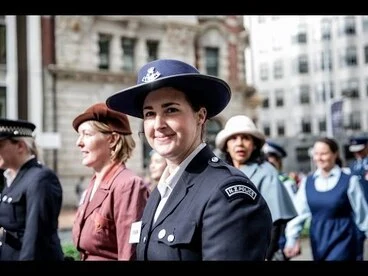


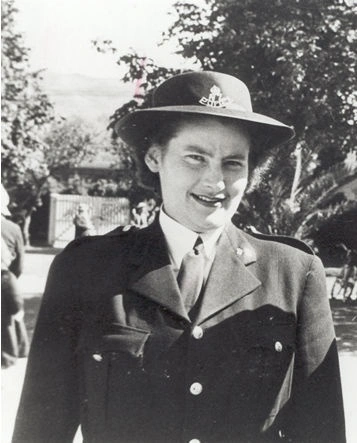
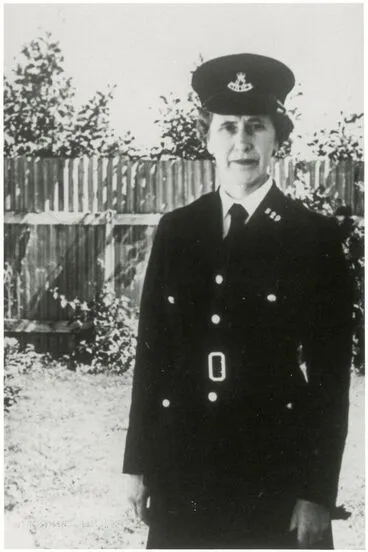
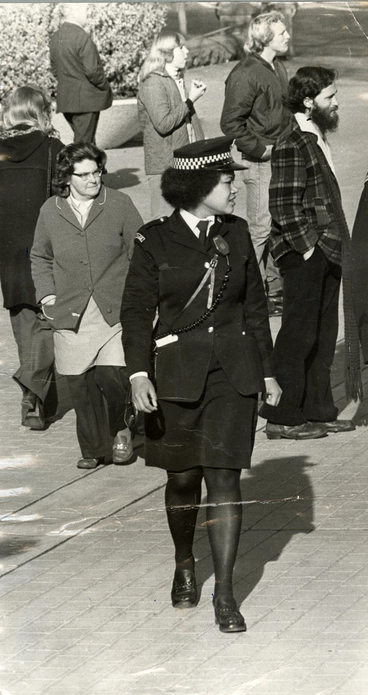
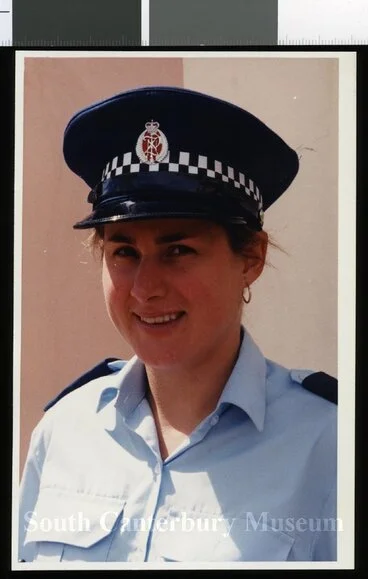
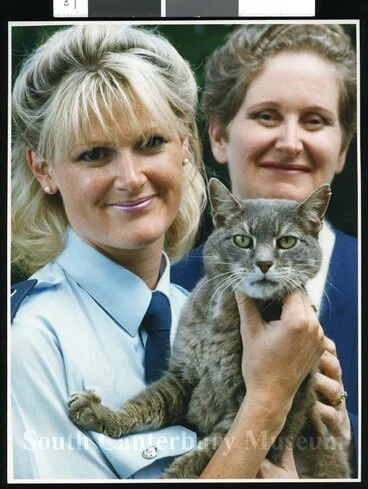
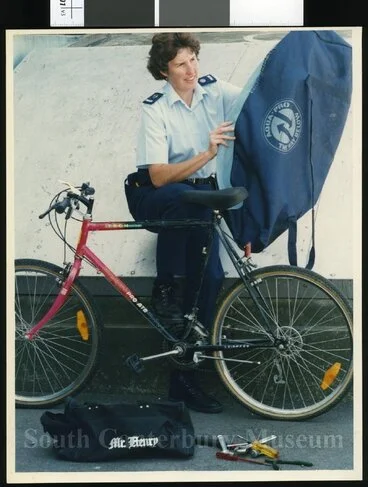
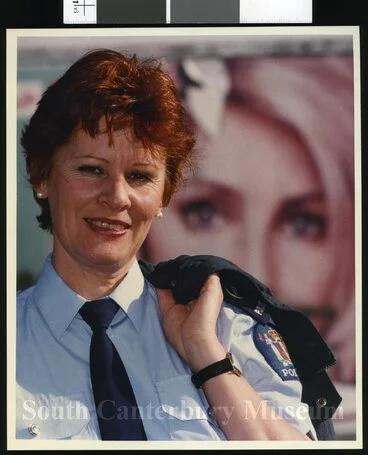
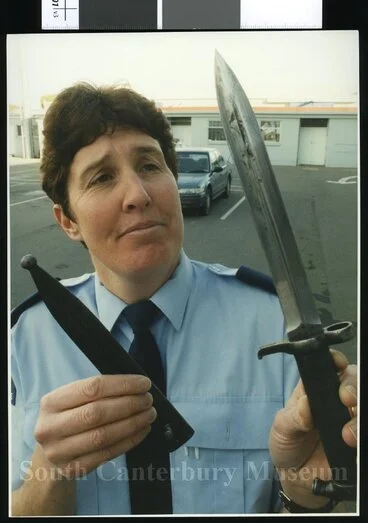
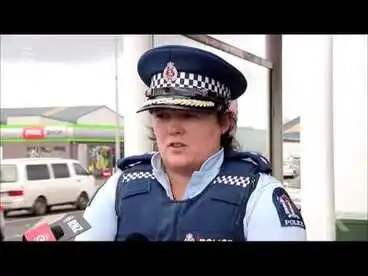

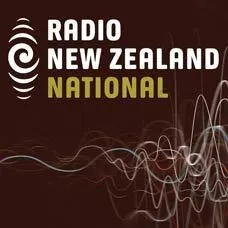
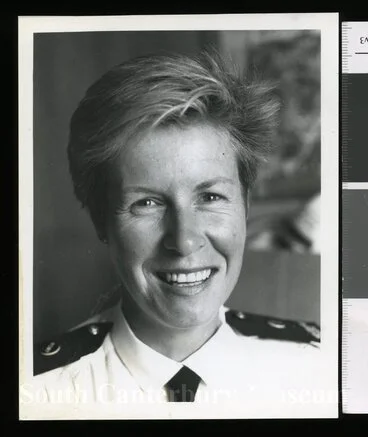





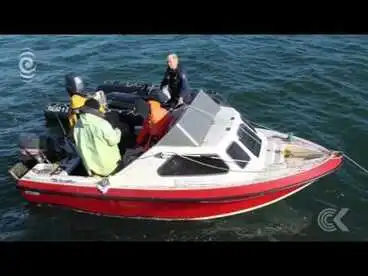

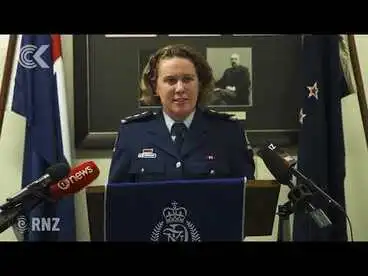
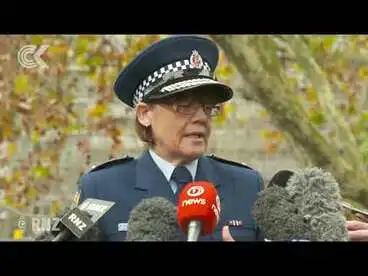



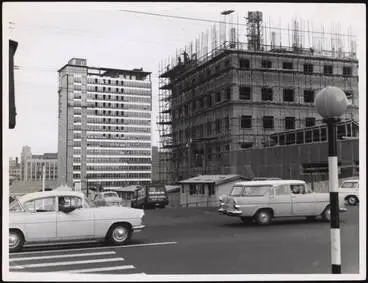
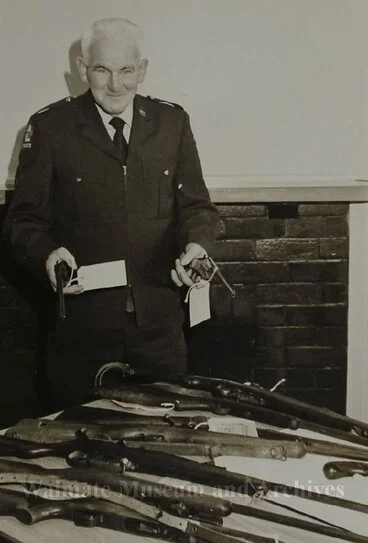



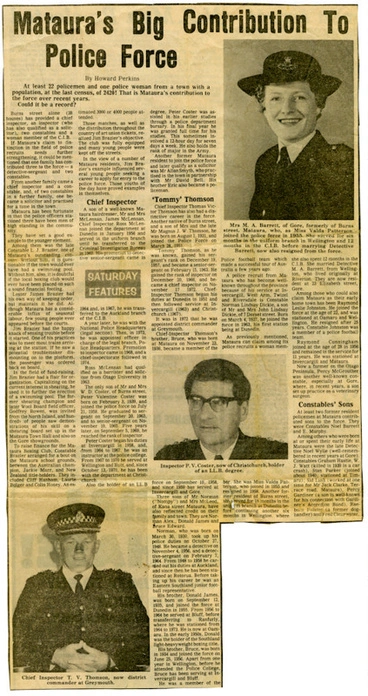


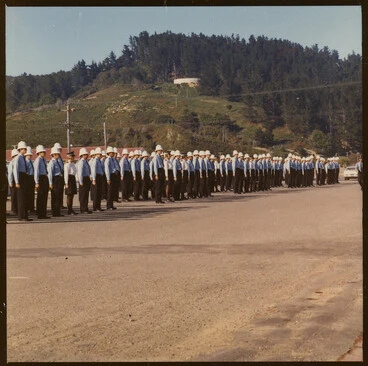

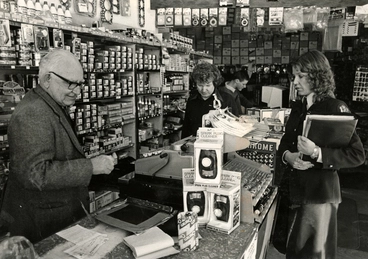







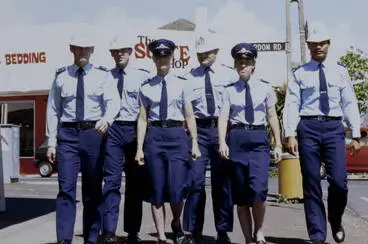


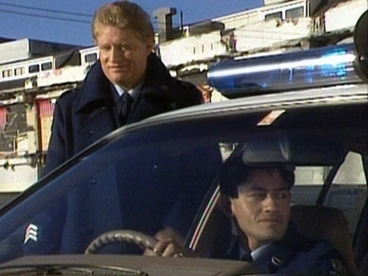




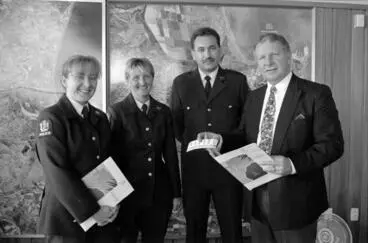


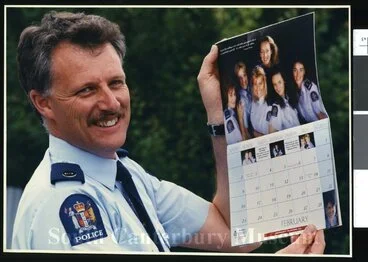

![[Timaru Traffic officers and vehicles] Image: [Timaru Traffic officers and vehicles]](https://thumbnailer.digitalnz.org/?resize=770x&src=https%3A%2F%2Fs3.amazonaws.com%2Fpastperfectonline%2Fimages%2Fmuseum_58%2F110%2F7285.jpg&resize=368%253E)





